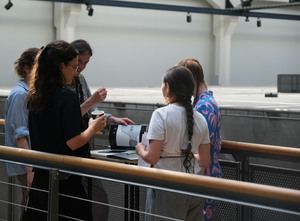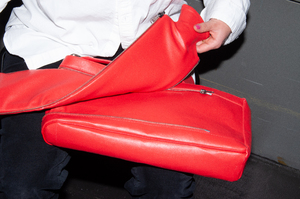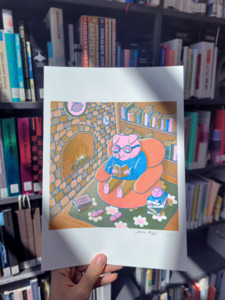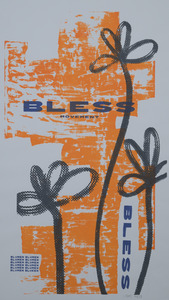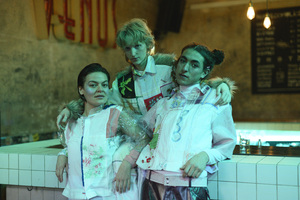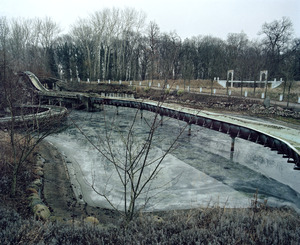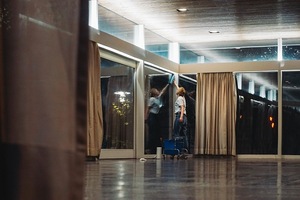DNS #68
Benachbarte Sets (119)Alle Zusammenhänge anzeigen
Diese Sets wurden den gleichen Sets hinzugefügt wie das ausgewählte Set.
119 Inhalte
- Seite 1 von 10
Approaching X
- Titel
- Approaching X
- Autor/in
- Beschreibung (en)
- What is X anyway? What does X mean to me and what does it mean to others? Where is X used and what do we see in it? What do we project onto X? Do we need to define X?
This projects goal was to find an approach to what the letter, the symbol, the figure X means to different people. Starting out as obsession with seeing the pattern of three Xes everywhere in my daily life , this work led to a collection of the meanings that X might or might not inherit and is an Invite to look for the pattern as well. I present my current approach to the theme of X; trying to find a way of connecting different ideas into a pattern. It runs through my life—and really through all of ours—and I share my perspective with the viewer. In my exhibition, I captured my exploration in 22 posters and a 130-page publication.
- What is X anyway? What does X mean to me and what does it mean to others? Where is X used and what do we see in it? What do we project onto X? Do we need to define X?
- Kategorie
- Typ des Projekts/Werks
- Schlagworte
- Datierung
- 02.07.2025
- Dank an
- Sprache
- Material
- Technik/Verfahren/Formate
- Lumbeck-Verfahren,
- Abmessungen
- 594X420
- Ort: Institution
- Ort
- Der Gang neben der PD-Sauna und dem Glaskubus im 2.OG, ebenfalls die Brücke zum ZKM im 2.OG
- Stadt
- Land
- Bemerkungen
- Dieses Projekt besteht teils aus eigenen, teils aus mir zugesendeten Bildern, deren Rechte mir übertragen wurden
- Titel
- Approaching X
- Importiert am
- 21.07.2025
- Übergeordnete Sets
- 0
- Set enthält
- 2 18
Honey
- Titel
- Honey
- Titel (en)
- Honey
- Untertitel
- hotbag
- Untertitel des Projekts/Werks (en)
- hotbag
- Autor/in
- Beschreibung (de)
- Wie können wir Wärme mobilisieren? Diese Handtasche mit integrierter Wärmflasche ist eine Antwort auf diese Frage. Sie wurde speziell entwickelt, um Menstruationsbeschwerden zu lindern, ohne diese natürlichen Bedürfnisse zu verbergen oder zu tabuisieren. Stattdessen setzt sie ein sichtbares und selbstbewusstes Statement, das zeigt: Wohlbefinden verdient Aufmerksamkeit und Designlösungen, bei denen weibliche Designerinnen eine zentrale Rolle im heutigen gesellschaftlichen Diskurs spielen. Die Tasche ist so konzipiert, dass sie Komfort auf Reisen bietet, beispielsweise bei der Arbeit oder in öffentlichen Räumen.
Die extra lange Wärmflasche für Bauch und Rücken speichert die Wärme stundenlang und lässt sich leicht wieder auffüllen. Ein modulares Reißverschlusssystem sorgt für Vielseitigkeit in der Anwendung, und eine thermische Einlage schützt vor Überhitzung im Inneren der Tasche.
- Wie können wir Wärme mobilisieren? Diese Handtasche mit integrierter Wärmflasche ist eine Antwort auf diese Frage. Sie wurde speziell entwickelt, um Menstruationsbeschwerden zu lindern, ohne diese natürlichen Bedürfnisse zu verbergen oder zu tabuisieren. Stattdessen setzt sie ein sichtbares und selbstbewusstes Statement, das zeigt: Wohlbefinden verdient Aufmerksamkeit und Designlösungen, bei denen weibliche Designerinnen eine zentrale Rolle im heutigen gesellschaftlichen Diskurs spielen. Die Tasche ist so konzipiert, dass sie Komfort auf Reisen bietet, beispielsweise bei der Arbeit oder in öffentlichen Räumen.
- Beschreibung (en)
- How can we mobilise heat? This handbag with an integrated hot water bottle is an answer to this question. It is specially designed to relieve menstrual pain without hiding or tabooing these natural needs. Instead, it makes a visible and confident statement that shows: Well-being deserves attention and design solutions, where female designers play a central role in today's social discourse. The bag is designed to provide comfort when travelling, for example at work or in public spaces.
The extra-long hot water bottle for for stomach and back retains heat for hours and can be filled up again easily. A modular zip system ensures versatility of use, and a thermal inlay protects against overheating inside the bag.
- How can we mobilise heat? This handbag with an integrated hot water bottle is an answer to this question. It is specially designed to relieve menstrual pain without hiding or tabooing these natural needs. Instead, it makes a visible and confident statement that shows: Well-being deserves attention and design solutions, where female designers play a central role in today's social discourse. The bag is designed to provide comfort when travelling, for example at work or in public spaces.
- Kategorie
- Typ des Projekts/Werks
- Schlagworte
- Datierung
- Februar 2025
- Material
- Technik/Verfahren/Formate
- textile Handarbeit
- Ort: Institution
- Ort
- Lichtbrücke
- Stadt
- Land
- Titel
- Honey
- Importiert am
- 17.07.2025
- Übergeordnete Sets
- 0
- Set enthält
- 0 9
Typography 1
- Titel
- Typography 1
- Titel (en)
- Typography 1
- Untertitel
- Characteristic Characters
- Untertitel des Projekts/Werks (en)
- Characteristic Characters
- Beschreibung (de)
- You’re the main characters! You’re such NPCs! Your character development was so good! Your character design is still a bit wonky! Sometimes you act out of character but you’re my favorite Characters! <3
Dieses Seminar ist eine praktische Einführung in die Typografie. Wir werden Buchstaben zeichnen und etwas über Schriftsysteme und das Alphabet lernen, Buchstaben zeichnen und ein Vokabular aufbauen, um über Buchstabenformen, die Unterschiede und Klassifizierungen von Schriften zu sprechen, Buchstaben zeichnen und die Lesbarkeit und den Charakter bewerten, Buchstaben zeichnen und einen Blick auf historische und zeitgenössische Kontexte wie Volkstypografie, Branding und Popkultur werfen.
- You’re the main characters! You’re such NPCs! Your character development was so good! Your character design is still a bit wonky! Sometimes you act out of character but you’re my favorite Characters! <3
- Beschreibung (en)
- You’re the main characters! You’re such NPCs! Your character development was so good! Your character design is still a bit wonky! Sometimes you act out of character but you’re my favorite Characters! <3
This seminar is a practical introduction to typography. We will draw letters and learn about writing systems and the alphabet, draw letters and build a vocabulary to speak about letterforms, the differences and classifications of typefaces, draw letters and evaluate readability and character, draw letters and look at historical and contemporary contexts such as vernacular typography, branding and pop culture.
- You’re the main characters! You’re such NPCs! Your character development was so good! Your character design is still a bit wonky! Sometimes you act out of character but you’re my favorite Characters! <3
- Typ des Projekts/Werks
- Schlagworte
- Datierung
- 23.10.2024 - 12.02.2025
- Mitwirkende
- Ort: Institution
- Ort
- 202
- Titel
- Typography 1
- Projektleiter/in
- Semester
- Studiengang
- Importiert am
- 12.06.2025
- Übergeordnete Sets
- 0
- Set enthält
- 0 30
Currents of Change
- Titel
- Currents of Change
- Autor/in
- Beschreibung (de)
- Was bedeutet es, zu fliehen, wenn die Strömungen einen immer noch unter die Haut ziehen?
„Currents of Change“ ist eine Eigenproduktion, die ich während meines Praktikums im Studio Riso Pop in Amsterdam geschrieben, illustriert und produziert habe. Es erzählt die Geschichte eines Oktopus, der sich auf der Suche nach Freiheit verändert – ein Spiegelbild des Kampfes ums Überleben in einer unsicheren Welt.
- Was bedeutet es, zu fliehen, wenn die Strömungen einen immer noch unter die Haut ziehen?
- Beschreibung (en)
- What does it mean to escape, when the currents still pull you beneath your skin?
"Currents of Change" is a self-made I wrote, illustrated and produced during my internship at the studio Riso Pop in Amsterdam. It tells the story of an octopus undergoing transformation to reshape itself in search of freedom – mirroring the struggle to survive in an uncertain world.
- What does it mean to escape, when the currents still pull you beneath your skin?
- Kategorie
- Typ des Projekts/Werks
- Schlagworte
- Datierung
- 2025
- Sprache
- Material
- Technik/Verfahren/Formate
- Risografie
- Ort: Institution
- Stadt
- Land
- Internetlinks
- Bemerkungen
- Interesse an einem Exemplar? Dann schreibe mir eine Mail an jkessler@hfg-karlsruhe.de
- Titel
- Currents of Change
- Semester
- Studiengang
- Lehrveranstaltung
- Archiv-Signatur
- Externes Archiv
- Importiert am
- 06.07.2025
- Übergeordnete Sets
- 0
- Set enthält
- 0 9
Love over Taste II
- Titel
- Love over Taste II
- Untertitel
- Piggy's World
- Autor/in
- Beschreibung (de)
- Meine künstlerische Arbeit beschäftigt sich mit Tierschutz, Veganismus und der Frage, warum wir bestimmte Tiere lieben und andere essen. Es ist ein Thema, das mich sowohl auf persönlicher als auch auf künstlerischer Ebene tief bewegt. Vor rund vier Jahren habe ich mich dazu entschieden, mich vegetarisch zu ernähren – und bin bald darauf vegan geworden. Mein jüngeres Ich, das meine Mutter liebevoll „kleine Fleischfresserin“ nannte, hätte sich das kaum vorstellen können. Und doch war der Impuls schon früh da. Ich erinnere mich an meinen achten Geburtstag auf den Philippinen: Meine Familie bereitete ein Fest vor, das Schwein im Garten meiner Tante wurde ausgewählt, geschlachtet, aufgespießt. Erst beim Anblick des toten Körpers auf dem Buffet wurde mir klar, was passiert war – und dass es wegen mir geschah. Das mulmige Gefühl, das ich damals im Bauch hatte, begleitet mich bis heute.
Inspiriert von Melanie Joys Buch Why We Love Dogs, Eat Pigs, and Wear Cows hinterfrage ich in meinem Projekt Love over Taste die gesellschaftlich akzeptierte Trennung zwischen „Nutztieren“ und „Haustieren“, zwischen Leben und Produkt. Im Mittelpunkt steht Piggy – ein liebevoll gestalteter, anthropomorpher Schweine-Charakter, der eine Stimme bekommt, wo Tiere in der Realität keine haben. Basierend auf Recherchen, Dokumentationen wie Dominion oder Mission Erde, erzählt Piggy seine Geschichte als Mastschwein – und findet zugleich in meinen Illustrationen eine Welt jenseits von Leid und Ausbeutung.
Piggy lebt in Szenen weiter, die eine Art Gegenrealität entwerfen: whimsical, freundlich, voller Leichtigkeit. In diesen Bildern ist Piggy allein oder mit seinen Tierfreund*innen zu sehen – in Momenten von Freiheit, Genuss, Selbstbestimmung. Durch die Vermenschlichung möchte ich Empathie wecken: Auch ein Schwein hat ein Recht auf ein leidfreies, selbstbestimmtes Leben.
Zum Projekt gehören neben den Illustrationen auch die Love over Taste Sticker, die Tiere zeigen, die häufig in der Massentierhaltung konsumiert werden – dargestellt mit einem liebevollen, persönlichen Blick.
Mit diesen kleinen, aber sprechenden Arbeiten möchte ich einen Raum öffnen für Gespräche über Mitgefühl, Carnismus und unsere alltäglichen Entscheidungen. Love over Taste ist eine Einladung, die Welt mit anderen Augen zu sehen – mit Piggy’s Augen.
- Meine künstlerische Arbeit beschäftigt sich mit Tierschutz, Veganismus und der Frage, warum wir bestimmte Tiere lieben und andere essen. Es ist ein Thema, das mich sowohl auf persönlicher als auch auf künstlerischer Ebene tief bewegt. Vor rund vier Jahren habe ich mich dazu entschieden, mich vegetarisch zu ernähren – und bin bald darauf vegan geworden. Mein jüngeres Ich, das meine Mutter liebevoll „kleine Fleischfresserin“ nannte, hätte sich das kaum vorstellen können. Und doch war der Impuls schon früh da. Ich erinnere mich an meinen achten Geburtstag auf den Philippinen: Meine Familie bereitete ein Fest vor, das Schwein im Garten meiner Tante wurde ausgewählt, geschlachtet, aufgespießt. Erst beim Anblick des toten Körpers auf dem Buffet wurde mir klar, was passiert war – und dass es wegen mir geschah. Das mulmige Gefühl, das ich damals im Bauch hatte, begleitet mich bis heute.
- Beschreibung (en)
- My artistic work deals with animal welfare, veganism and the question of why we love certain animals and eat others. It's a topic that moves me deeply on both a personal and artistic level. About four years ago, I decided to go vegetarian - and soon after became vegan. My younger self, whom my mother affectionately called ‘little carnivore’, could hardly have imagined it. And yet the impulse was there early on. I remember my eighth birthday in the Philippines: my family was preparing a feast, the pig in my aunt's garden was selected, slaughtered and speared. It was only when I saw the dead body on the buffet that I realised what had happened - and that it was because of me. The queasy feeling I had in my stomach back then is still with me today.
Inspired by Melanie Joy's book Why We Love Dogs, Eat Pigs, and Wear Cows, my project Love over Taste questions the socially accepted separation between ‘farm animals’ and ‘pets’, between life and product. At the centre is Piggy - a lovingly designed, anthropomorphic pig character who is given a voice where animals have none in reality. Based on research and documentaries such as Dominion or Mission Earth, Piggy tells his story as a fattening pig - and at the same time finds a world beyond suffering and exploitation in my illustrations.
Piggy lives on in scenes that create a kind of counter-reality: whimsical, friendly, full of lightness. In these images, Piggy can be seen alone or with her animal friends - in moments of freedom, pleasure and self-determination. By humanising them, I want to awaken empathy: A pig also has a right to a life free of suffering and self-determination.
In addition to the illustrations, the project also includes the Love over Taste stickers, which show animals that are often consumed in factory farming - depicted with a loving, personal view.
With these small but eloquent works, I want to open up a space for conversations about compassion, carnism and our everyday choices. Love over Taste is an invitation to see the world through different eyes - Piggy's eyes.
- My artistic work deals with animal welfare, veganism and the question of why we love certain animals and eat others. It's a topic that moves me deeply on both a personal and artistic level. About four years ago, I decided to go vegetarian - and soon after became vegan. My younger self, whom my mother affectionately called ‘little carnivore’, could hardly have imagined it. And yet the impulse was there early on. I remember my eighth birthday in the Philippines: my family was preparing a feast, the pig in my aunt's garden was selected, slaughtered and speared. It was only when I saw the dead body on the buffet that I realised what had happened - and that it was because of me. The queasy feeling I had in my stomach back then is still with me today.
- Kategorie
- Typ des Projekts/Werks
- Schlagworte
- Datierung
- 2024–ongoing
- Dank an
- Sprache
- Material
- Technik/Verfahren/Formate
- Risografie, Animation mit Hilfe von Cartoon Animator, Illustrationen in den Formaten A5 bis A3
- Abmessungen
- A5 bis A3
- Dauer
- ca. 12 Minuten Animation
- Ort: Institution
- Stadt
- Land
- Beteiligte Institution(en)
- Auftrag durch
- Tereza Ruller's Seminar All About Love
- Internetlinks
- Titel
- Love over Taste II
- Projektleiter/in
- Semester
- Studiengang
- Lehrveranstaltung
- Archiv-Signatur
- Importiert am
- 06.07.2025
- Übergeordnete Sets
- 0
- Set enthält
- 0 18
Blast or Bless 2024/2025
- Titel
- Blast or Bless 2024/2025
- Titel (en)
- Blast or Bless 2024/2025
- Untertitel
- Eine Einführung in den Siebdruck
- Untertitel des Projekts/Werks (en)
- An introduction into screen printing
- Beschreibung (de)
- Inspiriert vom Manifest des Vortizismus "Blast!" kreieren Studierende ein experimentelles, grafisches Poster als Teil des Siebdruck-Grundlagenkurses an der HfG. Während des viertägigen Kurses, der die praktischen und theoretischen Grundlagen der Druckvorstufe und des Siebdruckes an die Studierenden vermittelt, lernen Studierende über die historische und kunstgeschichtliche Entwicklung des Druckverfahrens und wie sie mit Ölkreide und Papierschablonen erste, experimentelle Siebe mit kleinem Budget herstellen können. Des Weiteren erfahren Studierende, wie sie ihre Motive und die Siebe vorbereiten, um sie fotografisch zu entwickeln, wie sie mit wasserbasierten Farben umgehen, die Drucktische einrichten, um die unterschiedlichen Ebenen ihres mehrfarbigen Posters zu registrieren und wie sie die Siebdruckrahmen im Anschluss entschichten.
- Beschreibung (en)
- Inspired by the "Blast!" Manifestos of Vorticism, students create an experimental, graphic poster as part of the screen printing foundation course at the HfG. During the four-day course, which teaches students the practical and theoretical basics of prepress and screen printing, students learn about the historical and art-historical development of the printing process and how they can use oil pastels and paper stencils to produce their first experimental screens on a small budget. Furthermore, students learn how to prepare their motifs and the screens in order to develop them photographically, how to deal with water-based inks, how to set up the printing tables to register the different levels of their multicoloured poster and how to decoat the screen printing frame.
- Kategorie
- Typ des Projekts/Werks
- Schlagworte
- Datierung
- 01.10.2024 - 01.08.2025
- Mitwirkende
- Titel
- Blast or Bless 2024/2025
- Projektleiter/in
- Semester
- Studiengang
- Importiert am
- 15.07.2025
- Übergeordnete Sets
- 0
- Set enthält
- 0 31
Anima Sola
- Titel
- Anima Sola
- Titel (en)
- Anima Sola
- Autor/in
- Beschreibung (de)
- Ein Fahrradschloss das leuchtet ist nicht nur eine naheliegende Zusammenlegung zweier Objekte die sich unter dem Sattel in die Quere kommen, sondern verhindert zur gleichen Zeit den Diebstahl akkubetriebener Rücklichter.
- Beschreibung (en)
- A bike lock that lights up is not only an obvious combination of two objects that contest the space under the saddle, but also prevents the theft of battery-powered rear lights at the same time.
- Typ des Projekts/Werks
- Schlagworte
- Datierung
- 18.07.2024
- Titel
- Anima Sola
- Projektleiter/in
- Studiengang
- Importiert am
- 18.07.2025
- Übergeordnete Sets
- 0
- Set enthält
- 0 8
Sekret
- Titel
- Sekret
- Untertitel
- Eine Tränen-Bar Performance
- Autor/in
- Beschreibung (de)
- In einer Bar, in der Innenstadt von Karlsruhe, trifft das Publikum auf ein tourendes Trio mit einer sonderbaren Geschichte: Es war einmal ein Nachtfalter, der lebte im Dschungel des brasilianischen Amazonas. Dieser Falter trug den Namen Gorgone macarea und hatte eine Angewohnheit, die für ein Lebewesen auf der Erde recht eigensinnig erschien. Gorgone macarea trank die Tränen schlafender Vögel. Für ihn: eine sichere Nahrungsquelle in unsicheren Zeiten. Da also Gorgone macareas Lebensraum sich immer mehr veränderte und auch die Vögel nach und nach wegzogen, machte der Falter sich auf, um andere Tränen zu suchen. Dabei kam ihm zu Ohren, dass der Mensch ganz besondere Tränen vergießt, wie kein anderes Lebewesen auf der Erde: Emotionale Tränen.
Und so entschloss sich der Nachtfalter, die Menschen einzuladen, um ihre Tränen mit ihm zu teilen.
Seither touren der Nachtfalter und seine zwei Kompliz*innen Sadgirl und Fluss von Bar zu Bar und lassen für einen Abend das Publikum Teil ihres Universums werden. Ein Universum – in dem Tränen die Hauptzutat des Abends sind und in jedem Cocktail serviert werden.
- In einer Bar, in der Innenstadt von Karlsruhe, trifft das Publikum auf ein tourendes Trio mit einer sonderbaren Geschichte: Es war einmal ein Nachtfalter, der lebte im Dschungel des brasilianischen Amazonas. Dieser Falter trug den Namen Gorgone macarea und hatte eine Angewohnheit, die für ein Lebewesen auf der Erde recht eigensinnig erschien. Gorgone macarea trank die Tränen schlafender Vögel. Für ihn: eine sichere Nahrungsquelle in unsicheren Zeiten. Da also Gorgone macareas Lebensraum sich immer mehr veränderte und auch die Vögel nach und nach wegzogen, machte der Falter sich auf, um andere Tränen zu suchen. Dabei kam ihm zu Ohren, dass der Mensch ganz besondere Tränen vergießt, wie kein anderes Lebewesen auf der Erde: Emotionale Tränen.
- Beschreibung (en)
- In a bar in downtown Karlsruhe, the audience encounters a touring trio with a peculiar story: Once upon a time, there was a moth living in the jungles of the Brazilian Amazon. This moth was called Gorgone macarea and had a habit that seemed rather unusual for a creature on Earth. Gorgone macarea drank the tears of sleeping birds. For the moth, it was a reliable source of nourishment in uncertain times. After all, even back then, the Amazon rainforest was considered a so-called tipping element, capable of disrupting the global climate balance. As Gorgone macarea’s habitat changed more and more, and the birds gradually disappeared, the moth set out in search of other tears. Along the way, it heard that humans shed a kind of tear unlike any other creature on Earth: emotional tears.
And so, the moth decided to invite humans to share their tears with it.
Since then, the moth and its two companions, Sadgirl and Fluss, have been touring from bar to bar, drawing the audience into their universe for one night. A universe where tears are the main ingredient of the evening—served in every cocktail.
- In a bar in downtown Karlsruhe, the audience encounters a touring trio with a peculiar story: Once upon a time, there was a moth living in the jungles of the Brazilian Amazon. This moth was called Gorgone macarea and had a habit that seemed rather unusual for a creature on Earth. Gorgone macarea drank the tears of sleeping birds. For the moth, it was a reliable source of nourishment in uncertain times. After all, even back then, the Amazon rainforest was considered a so-called tipping element, capable of disrupting the global climate balance. As Gorgone macarea’s habitat changed more and more, and the birds gradually disappeared, the moth set out in search of other tears. Along the way, it heard that humans shed a kind of tear unlike any other creature on Earth: emotional tears.
- Kategorie
- Typ des Projekts/Werks
- Schlagworte
- Datierung
- 20.12.2024
- Mitwirkende
- Dank an
- Dauer
- 40 Minuten
- Ort
- Venus Bar, Kaiserpassage
- Stadt
- Land
- Titel
- Sekret
- Projektleiter/in
- Semester
- Studiengang
- Typ der Abschlussarbeit
- Importiert am
- 26.02.2025
- Übergeordnete Sets
- 1
- Set enthält
- 0 15
Berge versetzen
- Titel
- Berge versetzen
- Titel (en)
- Moving mountains
- Autor/in
- Beschreibung (de)
- Bei den ausgestellten Arbeiten handelt es sich ausschließlich um Arbeiten neueren Datums. Bis auf die Arbeit „Treptow“ aus dem Jahr 2002 sind alle Arbeiten in den letzten 10 Monaten entstanden.
In meinen Arbeiten setze ich mich mit dem „Modellieren von Landschaft“ auseinander. Die Skulpturalität oder auch die Landschaftsmodellierung bilden den Mittelpunkt meiner Arbeiten. Die Form und deren illusionistisches Spiel treten dabei immer mehr in den Vordergrund. Ungewöhnliche Blickwinkel lassen den Standpunkt des Betrachters unklar und schaffen eine Unsicherheit über das Abgebildete. Durch eine bestimmte Art der Abbildung der Landschaftsskulpturen verlieren sie ihre ursprüngliche Bedeutung und zeigen oftmals die Absurdität der Handlungsweise des Menschen.
Alle Bilder sind in einem analogen Aufnahmeverfahren mit einer Großbildkamera entstanden. Nur unwesentliche digitale Eingriffe sind nötig, um dem abgebildeten Bildcharakter zu verleihen. Das bewusste Aufsuchen von ungewöhnlichen Orten und Blickwinkeln lässt oftmals die Vermutung einer digitalen Montage zu. „Berge versetzen“ ist eine Metapher sowohl für den plastischen als auch den skulpturalen Umgang mit Landschaft. Das Wegnehmen und Hinzufügen ganzer Berge oder Bergteile stehen stellvertretend für die Mächtigkeit des Eingriffs des Menschen in die Natur.
- Bei den ausgestellten Arbeiten handelt es sich ausschließlich um Arbeiten neueren Datums. Bis auf die Arbeit „Treptow“ aus dem Jahr 2002 sind alle Arbeiten in den letzten 10 Monaten entstanden.
- Beschreibung (en)
- The exhibited works are all recent. With the exception of the work “Treptow” from 2002, all the works were created in the last 10 months.
In my works I deal with the “modeling of landscape”. Sculpturality or landscape modeling is the focus of my work. The form and its illusionistic play increasingly come to the fore. Unusual perspectives leave the viewer's point of view unclear and create uncertainty about what is depicted. By depicting the landscape sculptures in a certain way, they lose their original meaning and often show the absurdity of human behavior.
All of the pictures were taken using analog photography with a large-format camera. Only insignificant digital interventions are necessary to lend the depicted image character. The deliberate search for unusual locations and angles often leads to the assumption of a digital montage. “Moving mountains” is a metaphor for both the plastic and sculptural treatment of landscape. The removal and addition of entire mountains or parts of mountains are representative of the power of human intervention in nature.
- The exhibited works are all recent. With the exception of the work “Treptow” from 2002, all the works were created in the last 10 months.
- Kategorie
- Schlagworte
- Technik/Verfahren/Formate
- Großbildkamera
- Internetlinks
- Titel
- Berge versetzen
- Projektleiter/in
- Semester
- Studiengang
- Typ der Abschlussarbeit
- Importiert am
- 08.11.2024
- Übergeordnete Sets
- 1
- Set enthält
- 0 6
Bio Design Lab
- Titel
- Bio Design Lab
- Beschreibung (de)
- Das Bio Design Lab ist ein hybrider und evolutiver Ort, der sowohl im digitalen als auch im physischen Raum existiert. Konzipiert als wachsende Plattform, die die Fachbereiche der Staatlichen Hochschule für Gestaltung miteinander verbindet, wird das Labor als Raum für Präsentation, Bildung und Wissensvermittlung genutzt.
Das Bio Design Lab konzentriert sich auf die lokale Region, ihre Ressourcen und Möglichkeiten und zielt aktiv darauf ab, die Produktionsweisen in Karlsruhe und Süddeutschland umzugestalten und neu zu überdenken. Zur Interaktion mit diesen Themen und Materialien, sowohl im digitalen als auch im physischen Raum, lädt das Labor lokale ExpertInnen und BesucherInnen gleichermaßen ein an gemeinsamen Projekten zu arbeiten.
Spuren dieser Aktivitäten komplementieren ein ständig wachsenden Netzwerk.Das Wissen über diese Ressourcen wird durch die Erstellung eines Know-how-Glossars und einer Materialbibliothek destilliert, durch virtuelle und physische Workshops vermittelt, sowie durch die Präsentationen herausragender Projekte, die sich mit nachhaltigen Materialien befassen, kommuniziert.
Das Labor fungiert als Inkubator und Modell für Zusammenarbeit und Produktion, das im Einklang mit dem aktuellen Wandel der Staatlichen Hochschule für Gestaltung Karlsruhe steht.
- Das Bio Design Lab ist ein hybrider und evolutiver Ort, der sowohl im digitalen als auch im physischen Raum existiert. Konzipiert als wachsende Plattform, die die Fachbereiche der Staatlichen Hochschule für Gestaltung miteinander verbindet, wird das Labor als Raum für Präsentation, Bildung und Wissensvermittlung genutzt.
- Beschreibung (en)
- The Bio Design Lab is a hybrid and evolutive environment that exists in both the digital and physical space. Conceived as a platform for connection and collaboration with local partners and using local resources, the Lab hosts the presentation, education and transmission of knowledge. As students and experts are invited to work on bio-design related projects, visitors can explore and interact with the Lab’s production and lines of inquiry.
Projects within the Lab focus on the local region, its materials and possibilities, and actively aim to reshuffle and rethink modes of production in Karlsruhe and the south of Germany. Topics under exploration include Algae, Soil, Plants, Body, and Agriculture. To interact with these themes and related materials, both within the digital and physical space, the Lab invites local experts and visitors alike.
Within the Bio Design Lab, regional resources are collected by connecting with local partners; they are then distilled through the making of a know-how glossary and a material library, aiming to develop local materials. The knowledge around these resources is disseminated through virtual workshops and multimedia presentations of outstanding projects dealing with sustainable materials. Ultimately, traces of these activities will remain in a constantly growing network, both in the digital platform and in physical displays of existing and future objects.
The Lab works as an incubator and a model for collaboration and production that is in line with the current transformation of the Karlsruhe University of the Arts and Design Karlsruhe. It was first presented to the public in the context of Critical Zones, an exhibition at ZKM | Center for Art and Media.
- The Bio Design Lab is a hybrid and evolutive environment that exists in both the digital and physical space. Conceived as a platform for connection and collaboration with local partners and using local resources, the Lab hosts the presentation, education and transmission of knowledge. As students and experts are invited to work on bio-design related projects, visitors can explore and interact with the Lab’s production and lines of inquiry.
- Schlagworte
- Ort: Institution
- Ort
- Bio Design Lab
- Stadt
- Land
- Internetlinks
- Titel
- Bio Design Lab
- Projektleiter/in
- Importiert am
- 23.10.2023
- Übergeordnete Sets
- 0
- Set enthält
- 5 2
Between the 'No Longer' and the 'Not Yet'
- Titel
- Between the 'No Longer' and the 'Not Yet'
- Autor/in
- Beschreibung (de)
- Der Titel dieser Ausstellung, "Between the 'No Longer' and the 'Not Yet'", stammt aus den Schriften von Victor Turner über Liminalität. Turner beschreibt Liminalität als einen Übergangszustand – einen Moment, in dem man eine frühere Rolle oder einen früheren Status verlassen hat aber noch nicht vollständig in eine neue Position eingetreten ist. Es ist ein Zustand der Ungewissheit und Transformation. Vertraute Strukturen lösen sich auf und lassen einen in einer undefinierten und instabilen Lage zurück.
Dieses Konzept spiegelt meine Erfahrung als Ausländerin in Deutschland wider. Ich habe Korea verlassen, befinde mich aber noch immer in einem Schwebezustand, ohne mich vollständig angekommen zu fühlen. Um diesen Zustand des Dazwischen auszudrücken, habe ich Flure als visuelle Metapher verwendet. Beim leisen Umherwandern durch diese Flure, beim Fotografieren aus der Distanz, bin ich mir selbst begegnet.
Aus dem fotografischen Projekt entwickelte sich die Videoarbeit "The Act of Cleaning" (2025), die gemeinsam mit den Fotografien gezeigt wird. Inspiriert von Mary Douglas' Ideen zu Reinigungsritualen – bei denen das Säubern Ordnung in das Chaos bringt –, habe ich das Putzen zu meinem eigenen Ritual gemacht. Douglas argumentiert, dass Gesellschaften Ordnung schaffen, indem sie Dinge in klare Kategorien einteilen. Doch Wesen oder Konzepte, die sich diesen Kategorien entziehen – wie Migrant*innen, Hybride oder diejenigen in Übergangszuständen –, werden oft als störend empfunden. In diesem Kontext wurde das Reinigen zu einem Weg, mit der Spannung des Dazwischenseins umzugehen.
Mit bloßen Händen wischte ich jede Stufe der Treppen ab, durch die ich mich bewegte. Die Reibung zwischen Lappen und Boden, das Geräusch des ausgewrungenen Wassers und das Echo meiner Schritte füllten den Flur. Der Boden wurde vollkommen durchnässt – die Grenze zwischen Reinigen und Verschmutzen verschwamm. Diese repetitive, beinahe meditative Handlung veränderte meine Beziehung zu diesen Räumen. Das Putzen wurde mehr als eine praktische Geste – es wurde zu einem Akt, meine Präsenz zu behaupten und sie zugleich zu hinterfragen.
Wie kann ich hier existieren?
- Der Titel dieser Ausstellung, "Between the 'No Longer' and the 'Not Yet'", stammt aus den Schriften von Victor Turner über Liminalität. Turner beschreibt Liminalität als einen Übergangszustand – einen Moment, in dem man eine frühere Rolle oder einen früheren Status verlassen hat aber noch nicht vollständig in eine neue Position eingetreten ist. Es ist ein Zustand der Ungewissheit und Transformation. Vertraute Strukturen lösen sich auf und lassen einen in einer undefinierten und instabilen Lage zurück.
- Beschreibung (en)
- The title of this exhibition, "Between the 'No Longer' and the 'Not Yet'", comes from Victor Turner's writings on liminality. Turner describes liminality as a transitional state—when one has left behind a previous role or status but has not yet fully entered a new one. It is a state of ambiguity and transformation. Familiar structures dissolve, leaving one in an undefined and unstable position.
This concept reflects my experience as a foreigner in Germany. I left Korea, yet I find myself lingering in a liminal state, not fully settled. To convey this in-between state, I used hallways as a visual metaphor. Wandering through hallways quietly, photographing them from a distance, I came face to face with myself.
This photographic project developed into the video work, "The Act of Cleaning" (2025), which is presented alongside the photographs. Inspired by Mary Douglas's ideas on purification rituals—where cleaning imposes order on chaos—I chose cleaning as my own ritual. Douglas argues that societies create order by classifying things into clear categories. Yet, beings or concepts that defy these categories—such as migrants, hybrids, or those in transitional states—are often seen as unsettling. In this context, cleaning became a way to navigate the tension of existing in ambiguity.
Using my bare hands, I wiped down each step of the staircases I walked through. The friction between the rag and the floor, the sound of squeezing water, and the echo of my footsteps filled the hallway. The floor became completely soaked, blurring the boundary between cleaning and staining. This repetitive, almost meditative act transformed my relationship with these spaces. Cleaning became more than a practical gesture—it was a way to assert my presence while simultaneously questioning it.
In what ways can I exist here?
- The title of this exhibition, "Between the 'No Longer' and the 'Not Yet'", comes from Victor Turner's writings on liminality. Turner describes liminality as a transitional state—when one has left behind a previous role or status but has not yet fully entered a new one. It is a state of ambiguity and transformation. Familiar structures dissolve, leaving one in an undefined and unstable position.
- Kategorie
- Typ des Projekts/Werks
- Schlagworte
- Datierung
- 29.05.2025
- Mitwirkende
- Dank an
- Ort: Institution
- Ort
- Lichthof
- Stadt
- Land
- Titel
- Between the 'No Longer' and the 'Not Yet'
- Projektleiter/in
- Semester
- Studiengang
- Typ der Abschlussarbeit
- Importiert am
- 29.05.2025
- Übergeordnete Sets
- 1
- Set enthält
- 0 9
Prolog 1 (Pavillon)
- Titel
- Prolog 1 (Pavillon)
- Titel (en)
- Prolog 1 (Pavilion)
- Autor/in
- Beschreibung (de)
- Die Arbeit Prolog 1 (Pavillon) begann mit einem künstlerischen Interesse an den raumvermessenden, kartographierenden Aspekten des Putzens – als Prinzip der Aneignung – sowie seiner skulpturalen Qualität.
Die Arbeit, die am 23. Oktober 2018 von 17-20 Uhr in einem rundumverglasten Pavillon der 1960er Jahre Moderne, an der Brauer-, Ecke Gartenstraße in Karlsruhe stattfand, bestand auf Handlungsebene aus dem Putzen des Inneren des Pavillons. Über vier an den Ecken des Pavillons angebrachte Lautsprecher hörten die sich im umliegenden Park befindenden Besucher*innen Textfragmente über den Pavillon: seine räumliche Verortung, seine (Un)-Zugänglichkeit auf institutioneller und baulicher Ebene sowie seine Architektur – Akten, Erzählungen, Spekulationen. Über drei Stunden Laufzeit verdichteten sich diese immer auch durch die Folie des Putzaktes ausgesuchten, verfassten und montierten Textfragmente zu einer offenen Erzählung.
Aus einer ursprünglich intuitiven Affinität zu diesem Ort sollte die Arbeit über das Putzen in genau diesem Pavillon stattfinden – Architektur der Nachkriegsmoderne, ein Kantinengebäude, angeblich von Egon Eiermann erbaut. Ein Gebäude, das der vielbefahrenen Straßenkreuzung den Rücken zudreht, eigentlich prominent platziert ist, aber von den meisten Passierenden unentdeckt bleibt – ein Ort, der auf vielen Ebenen changiert zwischen Sichtbarkeit, Unzugänglichkeit, Intransparenz und Mysterium.
Erst durch den langen Prozess, überhaupt Zugang zu dem ungenutzten Hochparterre des Gebäudes zu erhalten, und die damit einhergehenden intensiven Nachforschungen, verschob sich der Fokus der Arbeit hin zum Gebäude selbst und seiner schwer zu durchdringenden, sich nie ganz ergründenden Geschichte. Der Versuch, das Gebäude als Ausstellungsort zu nutzen, wurde in diesem Prozess Teil der Arbeit selbst.
So fanden diese unterschiedlichen Formen der Aneignung, das Putzen und die Recherche, letztlich wieder zusammen, am 23. Oktober 2018: einen Tag im Leben des Pavillons markierend, an dem alle Anwesenden zu Zeitzeug*innen seiner Existenz wurden. Die Besucher*innen befanden sich – die Textfragmente hörend – draußen im Park, während Judith Milz sich zeitgleich – als einzige Person – im Inneren des Pavillons befand, ihn drei Stunden lang putzte, während es draußen erst dämmerte und dann dunkel wurde, bis schließlich, Lichter aus, Tür zu, der Pavillon geputzt, der Abend vorbei war.
- Die Arbeit Prolog 1 (Pavillon) begann mit einem künstlerischen Interesse an den raumvermessenden, kartographierenden Aspekten des Putzens – als Prinzip der Aneignung – sowie seiner skulpturalen Qualität.
- Beschreibung (en)
- Prolog 1 (Pavilion) began with an artistic interest in the spatial and cartographic aspects of cleaning—as a principle of appropriation—as well as its sculptural quality.
The work, which took place on October 23, 2018, from 5 to 8 p.m., in a glass-walled pavilion from the modernist 1960s located at the corner of Brauerstraße and Gartenstraße in Karlsruhe, consisted, on the level of action, of cleaning the interior of the pavilion. Through four speakers mounted at the corners of the structure, visitors in the surrounding park could hear fragments of text about the pavilion: its spatial positioning, its (in)accessibility on both institutional and architectural levels, and its architecture—documents, narratives, speculations. Over the course of three hours, these curated, composed, and edited text fragments—always filtered through the act of cleaning—accumulated into an open-ended narrative.
The initial impulse to realize this work in exactly this pavilion arose from an intuitive affinity with the site—post-war modernist architecture, a former cafeteria building, allegedly designed by Egon Eiermann. A structure that turns its back on a busy intersection, prominently situated yet largely unnoticed by passersby—a place that wavers on many levels between visibility, inaccessibility, opacity, and mystery.
Only through the prolonged process of gaining access to the building’s unused raised ground floor—and the intensive research that this required—did the focus of the work begin to shift toward the building itself and its elusive, never fully graspable history. The attempt to use the building as an exhibition site ultimately became part of the work itself.
Thus, these different forms of appropriation—cleaning and research—converged once more on October 23, 2018: marking a day in the life of the pavilion on which all those present became witnesses to its existence. While the audience stood outside in the park listening to the audio fragments, Judith Milz—alone inside the pavilion—cleaned the space for three hours, as dusk settled and darkness fell, until finally, with the lights turned off and the door closed, the pavilion was cleaned, and the evening was over.
- Prolog 1 (Pavilion) began with an artistic interest in the spatial and cartographic aspects of cleaning—as a principle of appropriation—as well as its sculptural quality.
- Kategorie
- Typ des Projekts/Werks
- Schlagworte
- Datierung
- 23.10.2018
- Mitwirkende
- Sprache
- Material
- Dauer
- 3 Stunden
- Ort
- Pavillion, Brauer- Ecke Gartenstraße Karlsruhe
- Stadt
- Land
- Beteiligte Institution(en)
- Internetlinks
- Bemerkungen
- In den Archivierungsdokumenten finden Sie einen Text über die Entstehung der Arbeit. In der Online Fassung des PDFs sind zwei Informationen geschwärzt, die aber in der Hochschule für Gestaltung Karlsruhe vor Ort – bei Interesse – eingesehen werden können. Wenden Sie sich hierzu bitte an das Archiv der HfG Karlsruhe. Außerdem können Sie versuchen mich unter folgender Emailadresse zu erreichen: judith.friederike.milz@gmail.com
- Titel
- Prolog 1 (Pavillon)
- Projektleiter/in
- Semester
- Studiengang
- Typ der Abschlussarbeit
- Importiert am
- 30.07.2024
- Übergeordnete Sets
- 1
- Set enthält
- 0 14
